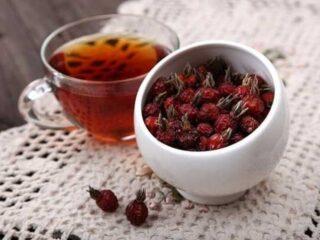Content
- 1 Is there a black rose hip?
- 2 What is the name of rosehip with black fruits?
- 3 What does black rose hips look like and where does it grow?
- 4 Types of black rose hips
- 5 Chemical composition
- 6 What are the benefits and benefits of black rosehip?
- 7 Contraindications to the use of black rosehip
- 8 When and how to collect black rose hips
- 9 Terms and conditions of storage
- 10 Conclusion
Black rose hips are a useful and beautiful plant with numerous medicinal properties. Under natural conditions, the culture is much less common than varieties with ordinary red fruits. But the value of the bush only increases from this.
Is there a black rose hip?
Most types of rose hips bear dark orange and red oval or elongated fruits. But in the wild and in ornamental cultivation you can also find a shrub with black berries.
In composition and properties, the variety is very similar to ordinary red.The plant has similar requirements for soil and light and is used to treat the same ailments. However, there are nuances that make the berries of the bush more useful for a number of diseases.
What is the name of rosehip with black fruits?
Black rose hips in botany are called spiny rose hips (Rosa spinosissima). You can also find it under the names of femoral or thin-legged rose.
What does black rose hips look like and where does it grow?
Black rose hips are widespread in Central Europe and in temperate climates in Asian countries. It has spreading arched shoots, rising on average 2 m above the ground. The branches of the prickly rose hips, in accordance with the name, are abundantly covered with needles. The leaves of the shrub are odd-pinnate, on long petioles; in the summer they are dark green, and in the fall they turn purple.
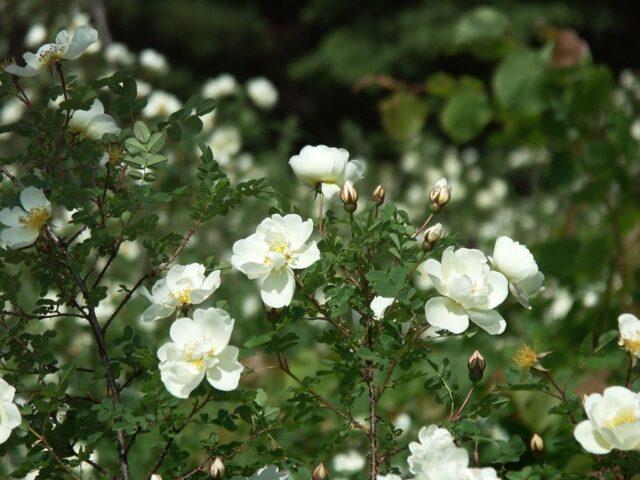
The decorative period of black rose hips lasts on average about two weeks
In May and June, black rose hips bear single flowers up to 6 cm in diameter. Their hue is most often white, although sometimes yellowish or creamy. By autumn, the fruits ripen - spherical dark hypanthia with nutty seeds inside. The pulp of the shrub berries is fibrous, covered with hard hairs. After ripening, the fruits do not fall off for a long time and remain on the branches until winter.
What is the difference between black rosehip and red rosehip?
From a scientific point of view, there are no fundamental differences between black and red rose hips. Plants belong to the same genus and family and have a similar external structure.
But at the same time, black rose hips contain more vitamin C - about 80% of the daily requirement in 100 g. This is almost 10% more than the same amount of red berries.
Types of black rose hips
Black rosehip in its natural habitat is represented by two species:
- Prickly rose Alteika (Rosa spinosissima Altaica). It has dark brown spiky shoots and light green jagged leaves. The flowers of the variety are simple in shape, white with golden-yellow stamens, the shade of the fruit varies from dark burgundy to pure black. It blooms once a season and grows naturally in Siberia and China.
The prickly rose hip Alteyka can withstand frosts down to - 34 ° C
- Rosa spinosissima var. spinosissima. The shrub has flexible shoots with long straight thorns and bears creamy white or slightly pinkish buds in the spring. In good conditions it can remain decorative until autumn. It is distinguished by small openwork leaves, the fruits are shiny, spherical, black. The shrub can withstand frosts down to -37 °C and prefers sandy soils.
The femoral thorny rosehip is found growing wild in South-West Asia and Europe
In general, the two varieties of plants are very similar to each other. The differences relate to the shade of the buds, the degree of endurance and some vegetative features. In ornamental breeding, the species are equally popular.
Chemical composition
The beneficial properties and photos of black rosehip arouse interest due to the rich composition of the plant.The fruits, green parts and wood of the crop contain:
- vitamins B1, B2 and B9;
- ascorbic acid;
- tanning components;
- iron, zinc and magnesium;
- vitamins PP and K;
- organic acids;
- natural sugars;
- potassium and manganese;
- tocopherol;
- pectins;
- phosphorus and copper.
Eating chokeberry is useful for preventing diseases and treating ailments. Dosages should be kept moderate, since the concentration of active substances in the berries is very high.
What are the benefits and benefits of black rosehip?
Chokeberry has numerous medicinal properties. When consumed in small dosages, the plant:
- protects against the development of vitamin deficiency and anemia;
- promotes rapid recovery from ARVI;
- strengthens immune resistance;
- inhibits bacterial growth and fights inflammation;
- helps prolong youth due to antioxidant properties;
- strengthens the walls of blood vessels and normalizes myocardial function;
- accelerates the healing of wounds, abrasions and cuts;
- cleanses the liver and improves its function.
Black rosehip is used as a preventive measure against cancer. The plant supports healthy cellular processes and prevents the growth of malignant tumors.
Which rosehip is healthier - black or red?
Both varieties of shrubs have valuable medicinal properties. Their fruits are used for the same diseases and are used in the same recipes.
At the same time, black rosehip contains much more vitamin C. For colds and inflammatory ailments, it is more useful and provides the fastest positive effect.
Black rosehip for immunity
Black rosehip tea helps with weakened immunity. You can prepare it according to this recipe:
- The ripe berries of the plant are washed and crushed by hand or using a blender.
- Place the mixture in the amount of two large spoons into a teapot.
- Pour 200 ml of fresh boiling water for ten minutes.
The finished tea is poured into cups through a strainer and taken 250 ml twice a day.
Black rosehip infusion for colds
Fresh black rose hips quickly relieve fever from a cold and improve your general condition. An infusion of berries is made as follows:
- The fruits are crushed with a pestle so that they release juice abundantly.
- Pour boiling water over the raw materials in a ratio of 1:6.
- Place in a glass container in a water bath for ten minutes.
- Remove from the stove, cover with a lid and wrap in towels for three hours.
The strained product can be consumed with honey three times a day.
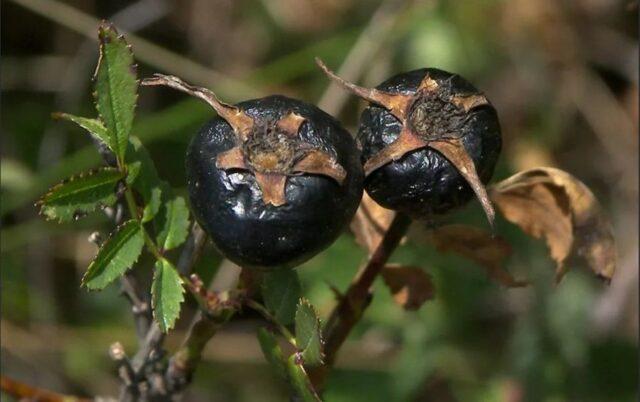
Black rose hips relieve nasal congestion and watery eyes for colds
Black rosehip for gum inflammation
The antibacterial and healing properties of the plant are good for periodontal disease and mechanical trauma to the gums. For treatment, the following remedy is used:
- About 40 dry black berries are placed in a thermos.
- Pour 1 liter of fresh boiling water.
- Leave covered overnight.
- In the morning, pass through gauze for filtration.
You need to drink the drug 150-200 ml at a time, twice a day.
Black rosehip for swelling
Chokeberry has diuretic properties and helps remove excess fluids from the body. To improve kidney function and eliminate edema, prepare a decoction of the roots of the plant:
- Grind two large spoons of dry raw materials.
- Pour 500 ml of boiling water.
- Simmer over low heat for about a quarter of an hour.
- Cool and filter.
You need to drink 70 ml of the decoction on an empty stomach three times a day. Sweeteners should not be added to the medicine.
Black rosehip infusion for conjunctivitis
For eye inflammation, it is recommended to prepare an infusion for external use from the white flowers of the plant. The recipe is as follows:
- Dried petals in a volume of 1/4 cup are poured into a thermos.
- Add 200 ml of boiling water and cover with a lid.
- Leave for 15 minutes and then strain.
Cotton pads are moistened in a warm preparation and applied to the eyelids as compresses for 10-15 minutes.
Black rosehip for flu
For flu and high fever, black rose hips are especially beneficial in combination with raspberries. The medicine is made according to the following recipe:
- Berries of both types are mixed in equal quantities, 15 g each.
- Pour a glass of boiling water over the fruits and place on low heat.
- Warm up for ten minutes.
- Remove from the stove and leave for a day to infuse.
The finished infusion should be strained from the remaining berries and drunk half a glass on an empty stomach in the morning and evening.
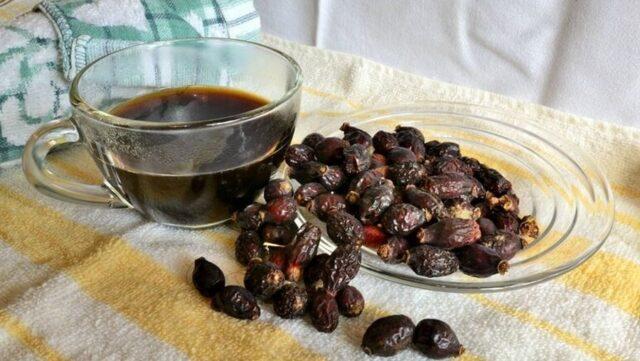
Rosehip infusion with the addition of raspberries is consumed for the flu for an average of up to a week
Contraindications to the use of black rosehip
The benefits of black rosehip are not the same for everyone. Berries have contraindications, which include:
- individual intolerance;
- severe diseases of the cardiovascular system;
- stomach ulcer and hyperacid gastritis in acute form;
- chronic inflammatory kidney diseases;
- large stones in the urinary tract and gall bladder.
During pregnancy, black rose hips are consumed in consultation with a doctor. The berries of the plant are good for colds and strengthen the immune system, but at the same time they increase uterine tone and can cause miscarriage.During breastfeeding, it is better to avoid fruits in order to avoid an allergic reaction in the newborn.
When and how to collect black rose hips
Black rosehip berries must be collected after full ripening - at the end of August or September. During this period, they acquire a particularly dark color and accumulate the maximum amount of useful substances.
For collection, choose a dry and warm day without precipitation. The work is carried out manually, and the skin must be protected with long sleeves and thick, high gloves, since the bush is very thorny. To ensure that the integrity of the berries is not compromised, they are picked along with the remains of the cups and stalks, and the excess parts are removed after drying.
Terms and conditions of storage
Fresh black rose hips cannot be stored for long periods of time. Even in the refrigerator, it will begin to rot in just 3-4 days. Therefore, berries are prepared for the winter using special processing.
Drying
After picking, the black fruits, along with the twigs and sepals, are laid out on a baking sheet or tray and left in a warm and well-ventilated place. In autumn, drying is usually carried out indoors, since the weather outside is rainy and cold.
You can speed up the fruit processing process by placing the raw materials in a dehydrator or oven at a temperature of about 50 °C.
The dried berries are poured into a glass jar or paper bag and stored in a dark place with a temperature of about 0 °C. The workpiece should not be exposed to sunlight during storage.
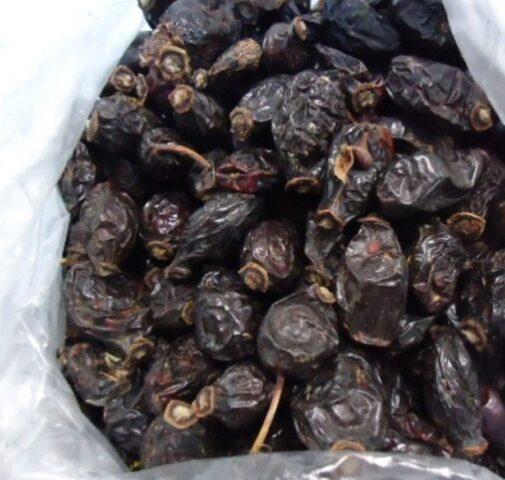
Dried black rose hips can be used for up to two years
Freezing
Fresh berries of the bush are washed to remove dust and dirt, and then laid out on a towel to dry from residual moisture. When the water droplets have evaporated, you will need to spread the fruits in a thin layer on a tray and put them in the freezer. The berries should not touch each other.
After 3-4 hours, the black fruits will need to be removed and poured into a plastic bag or plastic container, and then quickly put back in the refrigerator. Well-frozen berries will no longer stick together into a big lump. As needed, they can be removed from the packaging and used to prepare teas and infusions.
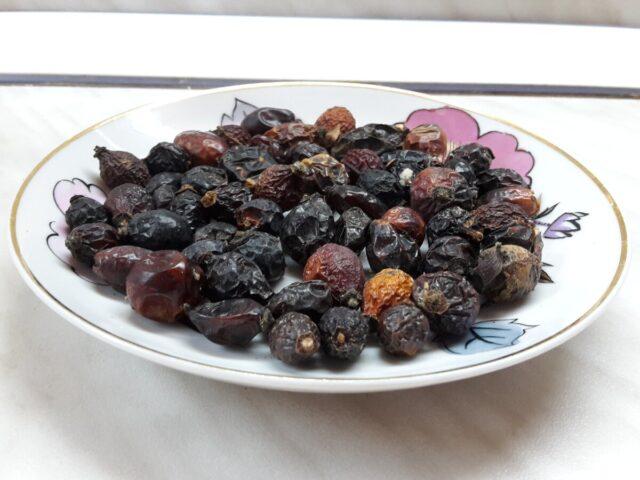
Frozen black rose hips can be stored for up to a year.
Conclusion
Black rose hips are a popular variety of shrub in landscape design and useful from a medicinal point of view. The berries contain a record amount of vitamin C, due to which the plant becomes especially valuable in the treatment of colds and inflammatory diseases.







